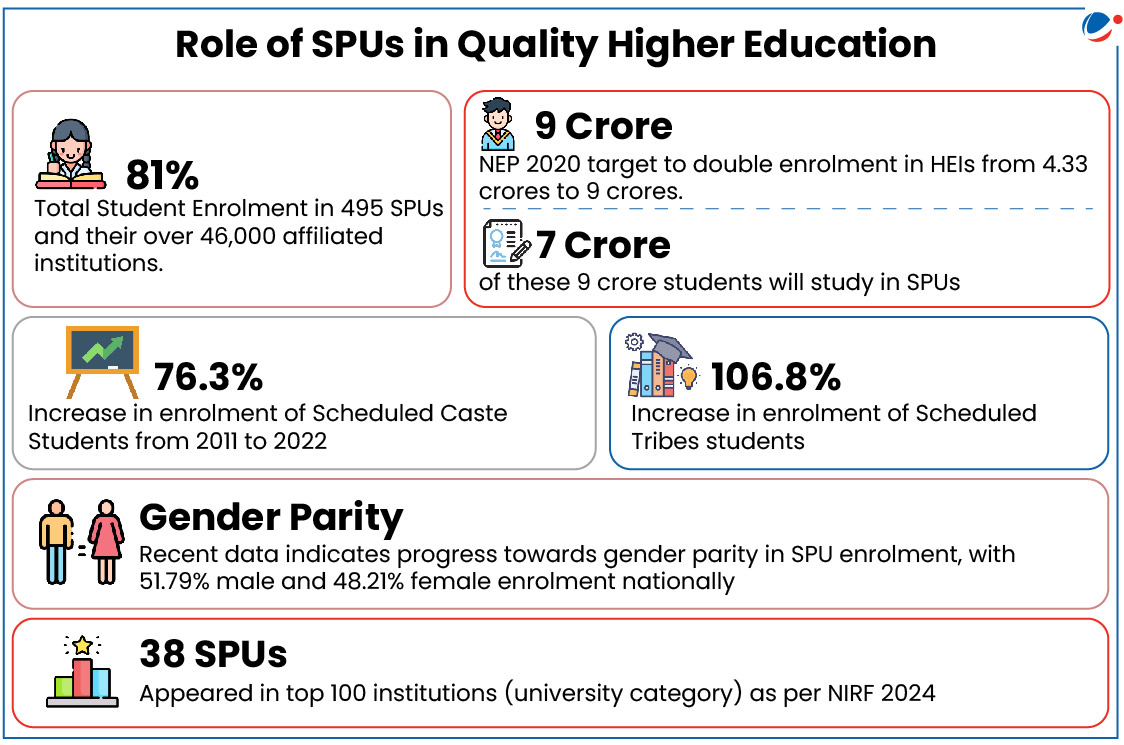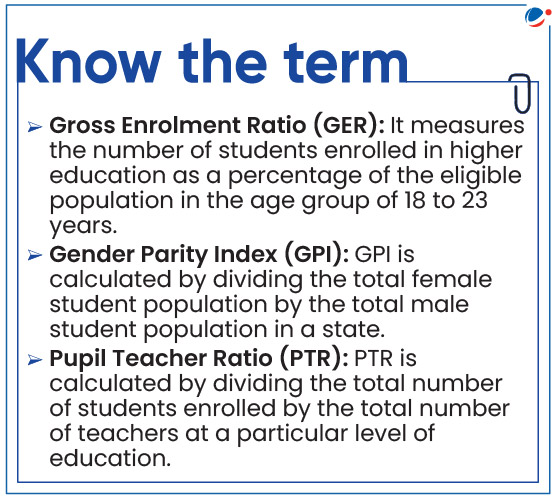Why in the News?
NITI Aayog launched a policy report titled 'Expanding Quality Higher Education through States and State Public Universities'.
State Public Universities
Universities established or incorporated by a Provincial Act or by a State Act, and funded by the State Government are called State Public Universities (SPUs).

Scenario of Higher Education in India
According to AISHE Report 2021-2022

- Access & Enrolment
- Institutions: There were 1,168 universities, 45,473 colleges and 12,002 stand-alone institutions in the country.
- Student Enrolment: Over 4 crore students, making India the second-largest after China.
- Gross Enrolment Ratio (GER): Increased 71 times from 0.4 (1950-51) to 28.4 (2021-22); National Education Policy (NEP) 2020 aims for 50% by 2035.
- Gender Parity Index (GPI): Improved from 0.87 (2011-12) to 1.01 (2021-22) (improvement of 16%).
- Quality & Research
- Pupil-Teacher Ratio (PTR): Steady at 23:1 for the last five years.
- Research: India's global research share grew from 3.5% (2017) to 5.2% (2024), but higher education contributes only 10% of total research output.
- Funding: Combined expenditure by the Centre and States (as % of GDP)-
- University & Higher Education: 0.62%
- Technical Education: 0.95%
- Overall Tertiary Education: 1.57% (outperformed most European nations, slightly behind the US & UK).
Key Challenges to Quality Higher Education in India
- Inefficient Accreditation System: After almost 35 years of the introduction of the NAAC accreditation system, less than 39% of universities nationwide have been accredited partly due to high costs of accreditation.
- Financing Gap: While India is fourth globally in terms of overall tertiary education budget, its per capita government expenditure on tertiary education is only about US$30.
- This is lower than many emerging countries like Brazil (2.6 times higher) and most developed countries like the USA (35 times higher).
- Suboptimal Research
- There is low expenditure on R&D by Government (around 0.7% of GDP), and by HEIs resulting in lower innovation outcomes.
- Researchers lack incentives such as funding, recognition, commercialisation of prototypes and career advancement opportunities. This results in lack of quality PhD students leading to faculty shortage.
- Policy & Governance Issues
- Multidisciplinary Education Gaps: No strong framework for MERUs (Multidisciplinary Education & Research Universities) and lack of dedicated policies in areas such as technology implementation, AI, data privacy etc.
- University Tax Burden: It impacts taxation on revenue of public universities, including CSR grants, and commercial rates for utilities, impacts their financial sustainability.
- Limited Autonomy: HEIs face lack of administrative autonomy including the freedom to decide fee or curriculum, impacting decision-making and hindering innovation.
- Regional Disparities: According to AISHE Report 2021-2022-
- University Density (per 1 lakh eligible students): Highest in Sikkim (10.3), Arunachal Pradesh (5.6), Ladakh (5.2), etc.
- In Bihar (0.2), UP (0.3), West Bengal & Maharashtra (0.6) the density is below national average
- GER:Southern states including Tamil Nadu (highest at 47) Kerala, Telangana, Andhra Pradesh have higher GER while Northern States of Bihar, Jharkhand, Odisha and Uttar Pradesh have low GERs.
- GPI:Kerala has highest GPI of 1.44, followed by Himachal Pradesh and Meghalaya, while Odisha and Tripura have lowest GPIs at 0.88 and 0.89 respectively.
- PTR: Better in Tamil Nadu (14), Goa, Karnataka, Kerala leads with a higher PTR than national average whereas Bihar (64), Jharkhand, MP, Chhattisgarh have a lower PTR.
- University Density (per 1 lakh eligible students): Highest in Sikkim (10.3), Arunachal Pradesh (5.6), Ladakh (5.2), etc.
Key Initiatives for Quality Higher Education
|
Way Forward for Quality Higher Education
- Funding and Financing: Ensure NEP-recommended budget allocation. Use Public-Private Partnerships (PPP) for infrastructure, research & skill development.
- For instance, Telangana Academy for Skill and Knowledge (TASK) was started as not-for-profit organization to bridge the industry-academia gap by offering quality human resources and services.
- Improving Governance: Shift to a 'regulatory-facilitator' model for Public Universities and grant greater autonomy in areas like curriculum development, faculty recruitment, etc.
- Improving infrastructure: For Instance, Odisha Higher Education Programme for Excellence and Equity (OHEPEE) covered 850 colleges focusing on uplifting educational standards and infrastructure.
- Improving Pedagogy: Develop a framework for evaluating teaching effectiveness and establish curriculum review committees within each university.
- Digitalization of Higher Education: Establish dedicated digital learning centres, adopt digital platforms for student lifecycle management.
- Kerala's 'Let's Go Digital' Initiative initiated digital learning initiatives through ICT-based teaching methods and digital course content.
- Improving Research Quality
- Policy Framework: Develop and implement a National Research Policy framework in alignment with the ANRF.
- Capacity Building: Develop capacity building programmes for faculty members and administrators.
- For instance, Maharashtra State Faculty Development Academy was established to enhance faculty capabilities.
- Internationalization of Higher Education: For instance, GIFT City in Gujarat allowed world-class foreign universities to establish campuses within its boundaries.
- Industry Academia Collaboration: Establish Industry Relations Cell (IRC) in universities and utilize existing industry association platforms like CII, FICCI, ASSOCHAM, NASSCOM etc.
- Establish incubation centers or co-working spaces to support student-led startups.



